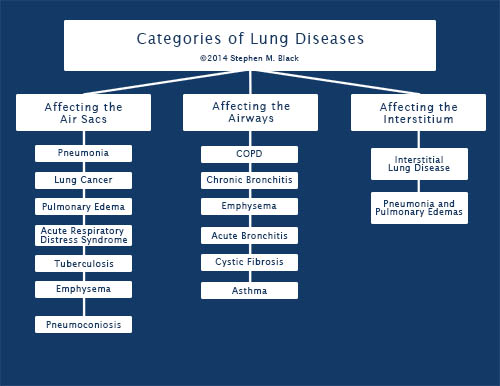
Stephen M. Black has categorized Lung Diseases into 3 different groups.
Stephen M. Black is a research chemist who specializes in Molecular Pharmacology and Molecular Endocrinology. Recently, he and his team of researchers have uncovered a new therapeutic treatment target for treating acute lung injury. To understand how this treatment works, it is important to understand the many diseases that can greatly affect a person’s quality of life.
Unfortunately, lung diseases are quite common and ten of millions suffer from lung disease in the United States alone. Frequent causes of lung disease can be attributed to genetics, infections, and smoking. The number of lung diseases are plentiful, and can break down into three categories: lung diseases that affect the air sacs, lung diseases that affect the airways, and lung diseases that affect the interstitium.
Lung Diseases Affecting the Air Sacs
- Pneumonia: an infection usually caused by bacteria that affects the alveoli.
- Lung cancer: often occurs in the main part of the lung, near the air sacs and have many forms.
- Pulmonary edema: caused when fluid leaks from the lung’s small blood vessels into the air sacs.
- Acute respiratory distress syndrome: sudden, severe injury to the lungs that usually requires mechanical ventilation until they recover.
- Tuberculosis: slowly progressive pneumonia caused by Mycobacterium tuberculosis.
- Emphysema: a result of damage to the connections between alveoli, typically caused by smoking.
- Pneumoconiosis: conditions caused by the inhalation of dangerous substances that injure the lungs.
Lung Diseases Affecting the Airways
- Chronic obstructive pulmonary disease: a lung condition inhibiting a person to exhale normally.
- Chronic bronchitis: a form of COPD that causes a chronic cough.
- Emphysema: lung damage that traps air in the lungs.
- Acute bronchitis: a virus that causes a sudden infection of the airways.
- Cystic fibrosis: a genetic condition that causes an accumulation of mucus resulting in repeated lung infections.
- Asthma: a condition where the airways are consistently inflamed, resulting in wheezing and shortness of breath.
Lung Diseases Affecting the Interstitium
- Interstitial lung disease: a collection of lung conditions that affect the interstitium.
- Pneumonia and pulmonary edemas: these lung diseases that affect the air sacs can also affect the interstitium.
Learn more about Stephen M. Black and his research on WordPress or by following him on Pinterest:http://pinterest.com/stephenmblack/
Related Posts: Lung Injury/Sepsis